Spot News Roundup
What a Hack!
What is a hack? That was the question animating the first annual MAKECU spring hardware hackathon, held over an intense 24 hours on campus from February 28 to March 1.
A new initiative for undergraduates launched by Columbia Engineering’s student chapter of the Institute for Electrical and Electronics Engineers (IEEE), MAKECU aims to expand Columbia’s maker culture and inspire the next generation of Columbia engineers.
Teams of two to four hackers, or makers, from Columbia and other schools including CUNY and the University of Maryland, had access to mentors, workshops, Columbia Engineering’s Makerspace, a standard circuits laboratory bench, and equipment including power supplies, an Arduino, oscilloscopes, and 3D printers, as well as unmodified hardware they brought themselves. After a keynote speech from Tom Igoe, cofounder of the open-source electronic prototyping platform Arduino, groups creatively repurposed everyday components in pursuit of ideas as diverse and ambitious as their imaginations.
Projects included Fruitbox Hero, which made instruments of bananas and oranges; Simon Says Move, a gesture-based memory game; Conduct II, a light-sensitive statistical notes generator; Don’t Push My Buttons, a glove with an embedded keyboard to help deaf people communicate; and CU_Later, a gesturecontrolled wheelchair.
After 20 hours of furious brainstorming, prototyping, and testing, the projects were evaluated by experts from Arduino, littleBits, Ardent Cell Technology, Altium, and Makerbot.
(Video by Jane Nisselson)
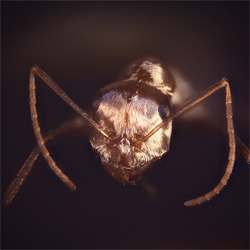
Cool Ants
Nanfang Yu, assistant professor of applied physics, has helped solve a long-standing evolutionary mystery in discovering how Saharan silver ants keep cool in one of the hottest, least hospitable environments on planet Earth.
Along with colleagues at the University of Zürich and the University of Washington, Yu demonstrated that the ants (Cataglyphis bombycina) are able to use their dense arrays of uniquely shaped hairs—which form distinctive silver coats that give the ants the appearance of mercury droplets flowing across the sands—to manipulate electromagnetic waves over a broad range from the solar spectrum to the thermal radiation spectrum to reduce body temperature. The African ants are thus able to forage for food in the Sahara Desert under the harsh midday sun, maintaining body temperatures below approximately 128˚F even as surface temperatures climb to as high as 158˚F.
Yu’s group, including his PhD students Norman Nan Shi and Cheng-Chia Tsai, used optical and infrared spectroscopy, thermodynamic measurements, full-wave simulations, and heat-transfer modeling to explore how the ants achieve passive cooling by reflecting visible and near-infrared light, where solar radiation culminates, and offloading excess heat in the form of mid-infrared thermal radiation.
In addition to illuminating how evolution has shaped exquisitely adapted structures to control infrared light—a topic not yet well understood—the research, Yu anticipates, will advance novel flat optical components, or “metasurfaces,” that exhibit optimal cooling properties for thermoregulation, with applications including cooling surfaces for buildings, vehicles, and clothing. His group is presently extending their research to other organisms living in extreme environments.
Yu, Shi, and Tsai designed and conducted all experimental work at Columbia Engineering and at Brookhaven National Laboratory’s Center for Functional Nanomaterials. Their research, published in Science magazine, was supported by the National Science Foundation and the Air Force Office of Scientific Research.
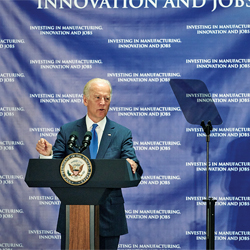
Biden Announces New York Photonics Innovation Hub
Columbia Engineering Professors Keren Bergman, Michal Lipson, and Alex Gaeta are a part of a new integrated photonics manufacturing innovation hub in Rochester, NY, announced by Vice President Joseph Biden on July 27. The American Institute for Manufacturing Integrated Photonics (AIM Photonics), a consortium of 124 companies, nonprofits, and schools, captured the largest federal investment to date under the administration’s National Network for Manufacturing Innovation, totaling over $610 million. Columbia is among the eight universities, which include SUNY Polytechnic Institute’s Colleges of Nanoscale Science and Engineering, MIT, UC Santa Barbara, University of Rochester, Rochester Institute of Technology, University of Arizona, and UC Davis.
Bergman, the Columbia lead for AIM Photonics, hailed the launch of the first U.S.-based manufacturing institute dedicated to integrated photonics.
“AIM Photonics will encompass the complete infrastructural ecosystem for fostering the growth of a new domestic industry propelled by the unique capabilities of integrated photonics to manipulate, transport, and control light at the chip scale,” said Bergman, “which will then catalyze the integration of powerful photonic capabilities in a multitude of industrial and military applications.”
The project highlights the research of the Columbia Nano Initiative, an interdisciplinary collective that advances innovation at the nanoscale. Columbia’s expertise in optically interconnected embedded computing via terabit-scale integrated photonics promises to spark a range of domestic manufacturing opportunities.
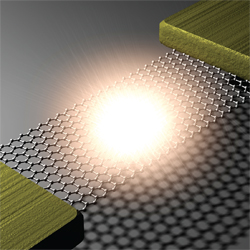
Graphene Gets Bright
An international research team led by Young Duck Kim, a postdoctoral research scientist in Mechanical Engineering Professor James Hone’s group, has pioneered what is essentially the world’s thinnest lightbulb. In June, they demonstrated for the first time an on-chip visible light source with a filament made of graphene, an atomically thin and perfectly crystalline form of carbon.
Creating light in small structures on chips’ surfaces is key to developing fully integrated “photonic” circuits that utilize light in place of electronic currents, but scientists have struggled with embedding incandescent lights onto chips because extreme heat tends to damage chip components. But because graphene becomes a poorer conductor of heat as it gets hot, it can reach extremely high temperatures while confining thermal energy sufficiently to avoid such damage.
Researchers attached small strips of graphene to metal electrodes, suspended the strips above the substrate, and passed a current through the filaments to make them glow brightly at temperatures above 2500˚C. The graphene emitted light bright enough to be visible with the naked eye.
Kim, Hone, and their collaborators from institutions across the United States and South Korea expect that their research will advance graphene-based on-chip optical communications and help create transparent, atomically thin displays. They are presently working on integrating these novel devices into flexible substrates.

Extreme Multitasking: Wireless Radio Edition
In a major advance for radio frequency data capacity that was long thought to be impossible, Columbia Engineering researchers have developed a technology enabling simultaneous transmission and reception at the same frequency in wireless radios.
The research team, consisting of Electrical Engineering Associate Professor Harish Krishnaswamy, director of the Columbia High-Speed and Mm-wave IC (CoSMIC) Lab, and PhD student Jin Zhou, developed full-duplex radio integrated circuits (ICs) that can be implemented in nanoscale complementary metal-oxide semiconductors (CMOS) to effectively double frequency spectrum resources and vastly enhance the data capacity of network infrastructure strained by the increasing profusion of wireless devices.
This technology, which the research team expects could be integrated into smartphones, tablets, and cellular and WiFi base stations, could help address one of the most fundamental challenges in the age of Big Data: the pressing shortage of frequency spectrum to support the continuing expansion of data transmitted wirelessly. The most vexing challenge the team was able to overcome with full-duplex technology was canceling the transmitter’s echo, or self-interference.
The researchers presented their work at the prestigious International Solid-State Circuits Conference (ISSCC) in San Francisco on February 25.
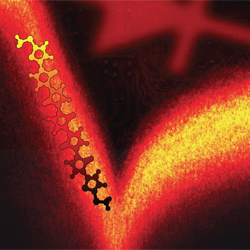
A Step Closer to a Single-Molecule Device
Under the direction of Latha Venkataraman, associate professor of applied physics, researchers have designed a new technique to create single-molecule diodes that perform 50 times better than all prior designs and are the first that may have broad real-world technological applications for nanoscale devices.
Constructing a device where the active elements are only a single molecule has long been a “holy grail” of nanoscience, representing the ultimate limit of functional miniaturization that can be achieved for an electronic device. Scientists have understood for decades that single molecules attached to metal electrodes can be made to act as a variety of circuit elements, from resistors and switches to transistors and diodes, but previous designs have suffered from low current flows and a lack of balance between flows for the “on” and “off” directions.
Venkataraman and her collaborators, including PhD student Brian Cappozi, Columbia Assistant Professor of Chemistry Luis Campos, and Professor Jeffrey Neaton at UC Berkeley, developed an elegant method for creating necessarily asymmetrical environments by surrounding active molecules with an ionic solution and using gold metal electrodes of various sizes to contact the molecules. Their technique is easy to implement and applicable to nanoscale devices of all types, including those made with graphene.
The researchers are now investigating the fundamental physics underlying their discovery and how to optimize current flows to maximize the molecular diodes’ charge-transport properties. Their paper, “Single-Molecule Diodes with High On-Off Ratios through Environmental Control,” was published in Nature Nanotechnology.
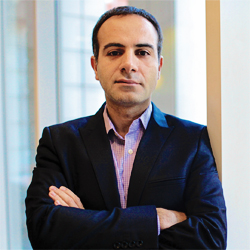
Speech and the Brain
Nima Mesgarani, assistant professor of electrical engineering, won a major research project grant this spring from the National Institute of Deafness and Other Communication Disorders (NIDCD-NIH) to support groundbreaking research on how the brain analyzes speech.
He is slated to receive $2 million over five years to support innovative, interdisciplinary work with colleagues at the Columbia University Medical Center (CUMC) recording highly detailed views of neural activity from electrodes surgically implanted in cortices of epilepsy patients as part of their clinical evaluations.
Mesgarani’s team uses a combination of invasive and noninvasive methods to study cortical mechanisms and transformations involved in speech perception with high spatiotemporal resolution, advancing understanding of how brains internally represent and follow voices of speakers and linking neural response characteristics and their dynamic properties.
The team is developing a detailed neurobiological model of the cortical functions underlying robust speech perception that should help researchers analyze how these processes are impaired in communication disorders like dyslexia, aphasia, and language-learning delay. The research promises to revolutionize disciplines including neurolinguistics and speech engineering, as well as speech prostheses.
Mesgarani, a member of Columbia University’s Neurobiology and Behavior Program, was also recently named a Pew Scholar by The Pew Charitable Trusts. Mesgarani will receive funding over the next four years in support of his research in neurophysiology, linguistics, and computational modeling to advance biologically inspired speech-recognition programs.

Print the Rainbow
A new computational technique is advancing the art and science of 3D printing in color, thanks to Assistant Professor of Computer Science Changxi Zheng and collaborators at China’s Zhejiang University.
The research team designed a computational model that predicts and accounts for color film distortion during hydrographic printing, widely used in industry to transfer color inks on thin films to the variegated surfaces of manufactured 3D objects. The printing involves placing a chemically softened polyvinyl alcohol film with printed color patterns on top of water, and slowly dipping an object so that the film wraps around and adheres to the object’s surface. The new technique has enabled the most precise alignment between objects and the patterned films ever attained, unlocking unprecedented versatility in 3D printing.
Zheng, a codirector of the Columbia Computer Graphics Group, built upon previous work on fluid and viscous sheet simulation to develop the new method for modeling and mapping color film stretch. He and collaborators developed and tested an innovative multi-immersion printing process that allows fine color printing on a variety of objects through multiple dips precisely calculated to achieve detailed textures and surface decorations.
The system is inexpensive, works for a variety of surface geometries and materials, and promises to be convenient for personal use. Zheng expects the system may be used for precise, personalized printing on products including toys and consumer goods.

Students Win Qualcomm Innovation Fellowship
Electrical Engineering PhD students Jelena Marasevic and Jin Zhou received a Qualcomm Innovation Fellowship for their proposal to increase wireless throughput in WiFi and cellular networks. They are one of just eight winning teams from a pool of 146 proposals that will receive $100,000 and mentorship from Qualcomm engineers over the next year to support their ongoing collaborative research to enhance upload and download speeds and enable more flexible use of wireless technology.
The students, advised by Associate Professors Harish Krishnaswamy and Gil Zussman, won for “Realizing the Full-duplex Potential of OFDM-based Networks: From Circuits to MAC Layer,” spanning the wide array of research they have done in full-duplex communication, which enables simultaneous transmission and reception in wireless radios at the same frequency.
Marasevic’s research concentrates on optimization techniques and algorithms to maximize the potential of full-duplex technology, while Zhou’s work focuses on innovative complementary metal-oxide semiconductor (CMOS) radio design to cancel out self-interference, or the transmitter’s echo. Their nontraditional work aims to make full-duplex communication a reality in both WiFi and small-cell-based LTE cellular networks, a major advance in wireless applications.
This was the fourth straight year that a team from Columbia Engineering has won the highly competitive fellowship from Qualcomm, one of the world’s largest wireless telecommunications companies.
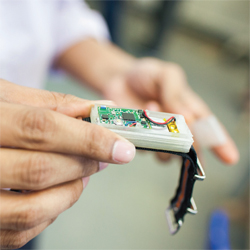
Engineering Your Style
As consumers seek to seamlessly integrate technology into their lives, wearable devices are an expanding field for engineers and entrepreneurs. Columbia Engineering graduate students showcased their own innovative designs this spring in the School’s first annual “Engineering Your Style” competition.
From an initial field of 20, five student teams received $500 to develop prototypes in Columbia Engineering’s Makerspace between October and February. On April 16, they pitched their ideas and demonstrated their proposals to judges including Electrical Engineering Professor John Kymissis, entrepreneur Adam Rapp BS’04, and Theanne Schiros, who teaches at Columbia and the Fashion Institute of Technology. Judges weighed each team’s marketability, innovation, and readiness to pursue commercial applications.
The competition was just too close to call, and two teams shared first place: Guide, a low-power customizable device with almost limitless potential applications, from mechanical engineering students Dhruv Nair and Vaibhav Paraashar; and Stride, an innovative insole for shoes with sensors to track gait and initiate vibrations to correct wearers’ steps and prevent injuries in real time, from electrical engineering students Omar Kiyani and Arvind Srinivasan.
The other contenders comprised a device to help people who rely on sign language to communicate in emergency situations, a portable EEG headset to analyze brainwaves, and a brain-computer interface that lets users play video games with their minds.
